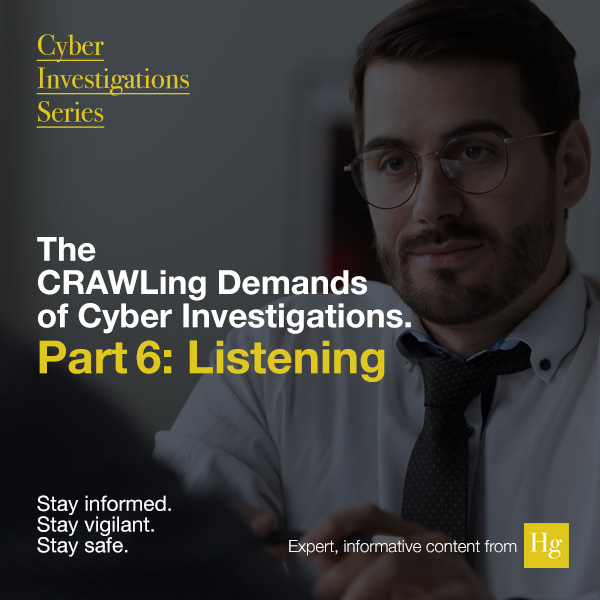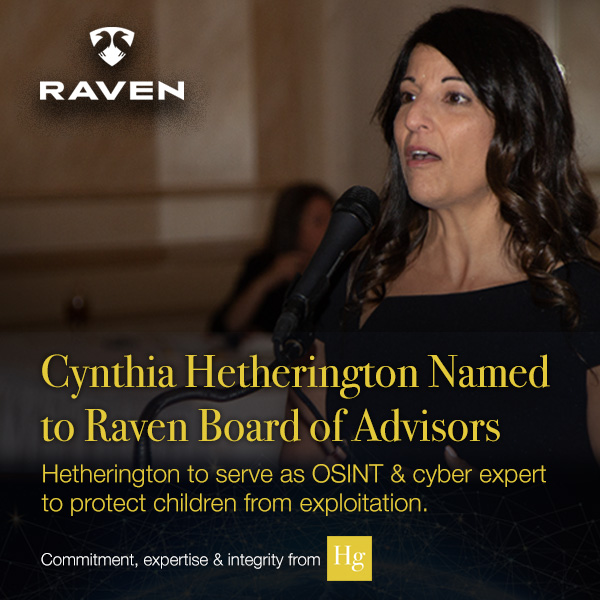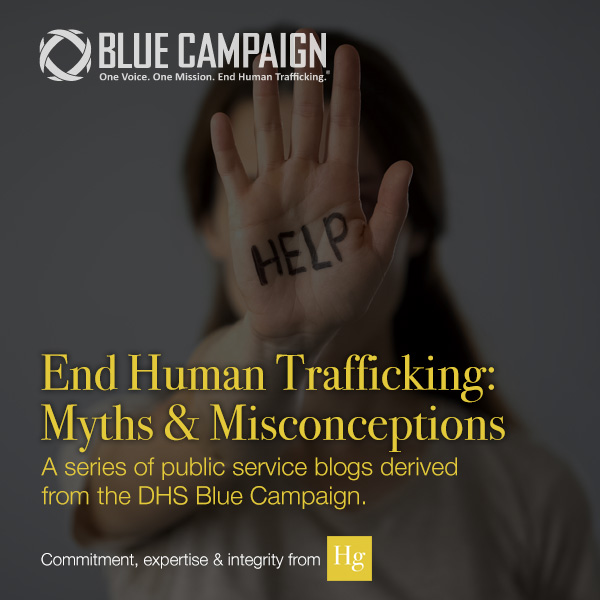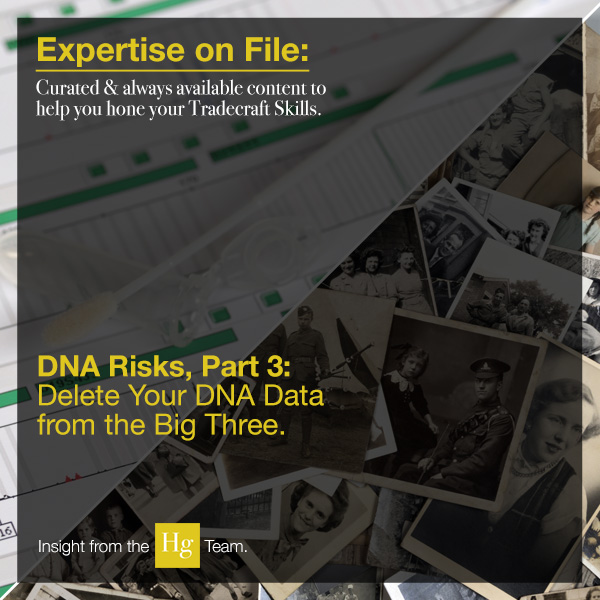By Cynthia Hetherington
 Do you have laser-like focus? Are you effective in communicating with clients? Diving deep to find the needle in that haystack? Able to absorb volumes of information, discern the facts, and write them in an orderly fashion? Does the old adage, “God gave us one mouth and two ears” speak to you? These are all traits required of a successful investigator. Before you set to work on any cyber investigation, you may need to learn how to CRAWL: Communicate, Research, Analyze, Write, and Listen.
Do you have laser-like focus? Are you effective in communicating with clients? Diving deep to find the needle in that haystack? Able to absorb volumes of information, discern the facts, and write them in an orderly fashion? Does the old adage, “God gave us one mouth and two ears” speak to you? These are all traits required of a successful investigator. Before you set to work on any cyber investigation, you may need to learn how to CRAWL: Communicate, Research, Analyze, Write, and Listen.
CRAWL allows investigators to implement a foundational approach for receiving new projects, reporting their findings, and transcending their competitors in customer-service response. Good investigators say that research is the most important step. Successful investigators say that analysis and good report writing can be very profitable. Great investigators know it is all in communicating with their clients, with an emphasis on listening. A solid investigator who is profitable, well-respected, and seeking steady work needs all five components.
Veteran investigators know that there are specialists in certain fields of research. Some fields of specialization are arson, surveillance, business backgrounds, organized crime, matrimonial, defense, and legal. As varied as these fields are, these experts all utilize the fundamentals of CRAWLing. CRAWLing demands skills beyond the investigator’s specialization.
CRAWLing is the business model for investigators, just as the scientific method is a constant for scientists.
Without a fundamental application of the principles of CRAWL, an investigator may have a short career, because she or he will not see return business, will become frustrated over inconsistent reports, and will not understand why the phone is not ringing. In this 6-part blog series, I will teach newbies how to CRAWL and help seasoned investigators refine their skills.
Last week we focused on how to Write your report. This week we focus on the art of Listening.
Two Ears are For Listening, One Mouth for Talking
Good listening is a necessary investigative skill that applies not only to conducting interviews but also when communicating with a client. In my rookie days working a tight deadline, I was typing a client report when a call came in from a new client. Although it would have been best to explain that I would call back immediately since I needed only five minutes to finish the other work, in my haste I began listening to the new client’s needs. The entire time I was discussing what the client wanted and replying with the probable cost and turn-around time, I was also busy and noisily typing my other report.
I got caught in the act.
The phone client asked me to stop what I was doing and give me his undivided attention. Since I was embarrassed, I tried covering up by saying I was taking notes for his case. But it was obvious that was an excuse when I needed to ask him to repeat points I missed because I was not paying attention.
Since then I do not answer the phone if am on a deadline, and when I do answer the phone, I tum my back from the computer and put a smile on. If you think the smile is silly, how many times have you spoken to someone on the phone who is obviously frowning, or stressed, or upset? It can be heard, if not seen.
Good Listening Skills
- Giving full attention to the speaker, maintain eye contact if in person or on a video call.
- Remain mentally engaged by determining the key points of the conversation. Since you will think faster than the speaker can talk, stay on track.
- Do not interrupt.
- Ask questions and give feedback.

The opportunity to use good listening can actually take place during four different phases with your client: 1) When hired; 2) during the investigation; 3) during the presentation of the report; and 4) your follow-up after completion. Each phase is important and should never be overlooked.
Track your Client’s Intentions
At the outset it is important to understand the client’s intentions. Make sure to listen thoroughly and attentively to the request. Keep in mind the client will most likely tell you what she thinks you can do and not what she wants. Ask questions that arise, even if they seem out of place. You want to be very thorough and get all the initial information needed.
Depending on the size of the case, the importance of the timeline, and if the client requests updates, I will stay in contact with the client throughout the investigation. It is a bad sign for any business if a client has to call you for an update. You should always initiate the communication, even if you have limited information to share. This practice is a constant reminder that you are working on their matter and that they are important to you.

Are you an analyst or investigator looking for introductory training on conducting OSINT investigations? If so, check out Hg’s August special webinar training package: Online Social Media Primer Series. This introductory primer series will teach you why to use these platforms, how to get into them, where to look, what nuances and leads you need to chase down, and how they are all interrelated. We’ll also discuss how to capture content per service, so you can present it in your reports.
 With over twenty-five years of global experience in open source investigations and one of the first investigative firms to conduct online social media investigations, Hetherington Group develops advanced cyber investigations unique to your needs. Learn how Hg’s analysts can clear through jargon and uncover answers buried deep in open sources, social media pages, and Dark Web sites.
With over twenty-five years of global experience in open source investigations and one of the first investigative firms to conduct online social media investigations, Hetherington Group develops advanced cyber investigations unique to your needs. Learn how Hg’s analysts can clear through jargon and uncover answers buried deep in open sources, social media pages, and Dark Web sites.
 Cynthia Hetherington, MLS, MSM, CFE, CII is the founder and president of Hetherington Group, a consulting, publishing, and training firm that leads in due diligence, corporate intelligence, and cyber investigations by keeping pace with the latest security threats and assessments. She has authored three books on how to conduct investigations, is the publisher of the newsletter, Data2know: Internet and Online Intelligence, and annually trains thousands of investigators, security professionals, attorneys, accountants, auditors, military intelligence professionals, and federal, state, and local agencies on best practices in the public and private sectors.
Cynthia Hetherington, MLS, MSM, CFE, CII is the founder and president of Hetherington Group, a consulting, publishing, and training firm that leads in due diligence, corporate intelligence, and cyber investigations by keeping pace with the latest security threats and assessments. She has authored three books on how to conduct investigations, is the publisher of the newsletter, Data2know: Internet and Online Intelligence, and annually trains thousands of investigators, security professionals, attorneys, accountants, auditors, military intelligence professionals, and federal, state, and local agencies on best practices in the public and private sectors.



